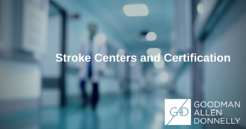
Four Levels of Stroke Certification for Hospitals
The major certification organizations (The Joint Commission, DNV-GL and HFAP) now offer 4 different levels of stroke certification for hospitals. (Locally, Bon Secours Mercy Hospitals are certified by The Joint Commission, Sentara and Riverside facilities by DNV-GL and Chesapeake Regional by HFAP.)
The four levels of certification are (TJC/DNV-GL/HFAP)
- Acute Stroke Ready Hospital (ASRH)/Acute Stroke Ready (ASR)/Stroke Ready
- Primary Stroke Center (PSC)/Primary Stroke Center (PSC)/Primary Stroke
- Thrombectomy Capable Stroke Center (TSC)/ Primary Plus Stroke Center (PSC+)/Thrombectomy Stroke
- Comprehensive Stroke Center (CSC)
Despite the different “names,” the requirements are similar and based on the same organizational guidance. In accord with guidelines established by the American Heart Association, American Stroke Association, and Brain Attack Coalition, advanced certifications for the various levels of hospital-based stroke care are offered to provide both providers and patients with hospital capabilities to ensure consistent and reasoned referral/care decision making. The treatment capabilities of the institution are the largest determinant in certification. All require an acute stroke team to be available 24/7 and at the bedside within 15 minutes.
ASRH (ASR/Stroke Ready) facilities have to have an initial assessment available by an ED physician, NP or PA. Neurology can be available 24/7 via telemedicine. Neurosurgery is available upon 3 hours transfer. IV thrombolytics are available. Full recommendations come from the Brain Attack Coalition for Acute Stroke Ready Hospitals (2013).[1]
In addition to the ASR requirements, PSCs or Primary Stroke facilities have dedicated stroke beds, 2 hour neurosurgery availability and thrombolytics and medical management are available in-house. Full recommendations come from the Brain Attack Coalition for Primary Stroke Centers (2011).[2]
The TSC, PCS+ or Thrombectomy Stroke facility must fulfill all of the requirements of the PSC plus the ability to perform intra-arterial thrombolytics and mechanical thrombectomy. In addition, the facility must have dedicated neuro intensive care beds and on-site critical care coverage. Recommendations come from the AHA/ASA Focused Update (2015).[3]
The Comprehensive Stroke Center (CSC) is the highest level of credentialing currently available and envisions the highest certification level of coordinated stroke care. In addition to all of the requirements for the PSC, CSCs must have 24/7 availability of neuro-interventionalist, neuroradiologist, neurologist and neurosurgeon. Treatments available include endovascular therapy, microsurgical clipping, neuro-endovascular coiling, stenting of extracranial carotid arteries and carotid endarterectomy. Recommendations come from the Brain Attack Coalition (2005).[4]
All in all, these designations and certifications provide both healthcare providers and the general public with global guidelines for determining referral options.
[1] Stroke. 2013; 44(12):3382-93
[2] Stroke. 2011; 42(9):2651-65
[3] Stroke. 2015; 46:3020-3035
[4] Stroke;.2005; 36(7):1597-616
This article originally published in Hampton Roads Physician Summer 2019 issue.
